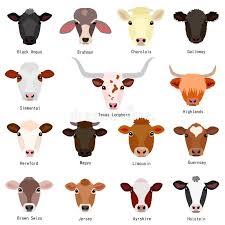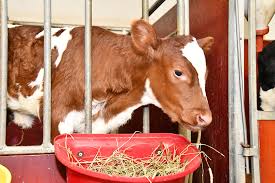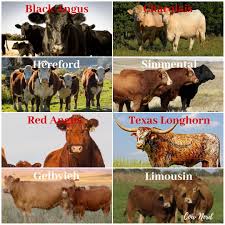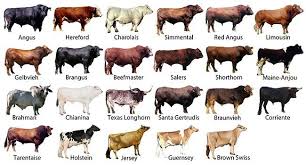Breeds of cattle are domesticated animals selectively bred for specific characteristics and purposes, primarily for dairy, meat, and draught work. The diversity among cattle breeds results from centuries of selective breeding, allowing farmers to optimize the traits they value most in livestock. Today, cattle are categorized into several types, each adapted to different climates, production needs, and agricultural practices.
While some breeds are renowned for their ability to produce high-quality milk, others are valued for their meat yield, resilience, or even as sources of leather and manure. Understanding the characteristics of various cattle breeds is essential for livestock farmers who aim to maximize productivity and adapt to local environmental conditions.
Globally, cattle breeds fall into two main categories: dairy and beef. Dairy breeds, such as the Holstein, Jersey, and Guernsey, are primarily bred for milk production and are often found on dairy farms. These breeds are distinguished by their high milk yield and the quality of their milk, which is crucial for dairy farmers seeking to supply markets with milk and milk-based products.
Holstein cattle, for example, are famous for their distinctive black-and-white markings and are one of the most productive dairy breeds, producing a significant volume of milk. In contrast, Jersey cattle are smaller but produce milk with a higher butterfat content, which is ideal for cheese and other dairy products that require rich milk.
On the other hand, beef breeds, such as the Angus, Hereford, and Charolais, are bred specifically for meat production. Beef cattle are generally more muscular, with physical characteristics suited for converting feed into high-quality meat efficiently.
Angus cattle, for example, are prized for their marbling, which enhances the flavor and tenderness of the meat. Similarly, Charolais cattle are known for their rapid growth rate and size, making them a popular choice for meat production. These breeds often thrive in various environments, allowing them to be raised in multiple regions worldwide, from temperate to tropical climates.
Besides dairy and beef breeds, there are also dual-purpose breeds, such as the Simmental and Shorthorn, which provide both milk and meat. These breeds are versatile and offer a balanced solution for small-scale farmers who want to benefit from both milk and meat production.
Additionally, some breeds are specifically adapted to specific climates or regions. For instance, the Brahman breed, originally from India, has adapted well to hot climates and is resistant to parasites. Such resilience makes Brahman cattle ideal for tropical environments, where heat and pests are common challenges.
Understanding the various cattle breeds and their specific characteristics helps farmers choose the right type of cattle for their needs, considering factors such as climate, land availability, and the intended purpose of the cattle. Selecting the right breed can lead to increased productivity, enhanced profitability, and a better adaptation to the challenges of modern agriculture.
Consequently, cattle breeding continues to evolve, with farmers and scientists working together to develop new breeds and improve existing ones. The goal is to ensure cattle breeds that not only meet current market demands but also adapt to future challenges, such as climate change and increasing food production demands.
Classification of Cattle Breeds

Cattle are generally classified into three main categories:
1. Dairy Breeds: Raised primarily for milk production, these breeds have been selected for their high milk yield and efficiency.
2. Beef Breeds: Focused on meat production, beef breeds grow quickly and provide high-quality meat, making them ideal for beef-focused farming.
3. Dual-Purpose Breeds: These breeds are suitable for both milk and meat production, making them versatile options for mixed farms.
For this article, we’ll look more closely at Dairy Cattle Breeds and Beef Cattle Breeds.
Dairy Cattle Breeds
Dairy breeds are specialized for milk production. They produce milk in large quantities and with high efficiency, often with varying levels of butterfat. Some popular dairy breeds include:
1. Holstein: Known for their black-and-white markings, Holsteins are the most common dairy breed worldwide. They have the highest milk production, but their milk has a lower butterfat content compared to other breeds.
2. Jersey: Jerseys are smaller than Holsteins and have a distinctive light brown coat. They produce milk with high butterfat content, making it ideal for butter and cheese production.
3. Guernsey: This breed is known for its golden-yellow milk, which is rich in beta-carotene. Guernseys are efficient grazers, making them well-suited for pasture-based systems.
4. Brown Swiss: Originating from Switzerland, Brown Swiss cattle are hardy and produce milk with a good balance of protein and fat. They also adapt well to various climates.
5. Ayrshire: These medium-sized cattle, originally from Scotland, produce high-quality milk with good butterfat levels. They are known for their hardiness and ease of management.
Beef Cattle Breeds
Beef breeds are selected for their ability to produce high-quality meat. These breeds tend to grow quickly and have a muscular build. Some well-known beef breeds include:
1. Angus: Known for their solid black or red color, Angus cattle are highly popular for their marbling and tender meat. They are hardy and adaptable to various climates.
2. Hereford: Herefords have distinctive red bodies and white faces. They are known for their docile temperament and high-quality beef, as well as their ability to thrive in challenging environments.
3. Charolais: Originating from France, Charolais cattle are large and white. They have high growth rates and provide lean, tender meat, making them popular in crossbreeding programs.
4. Limousin: Another French breed, Limousins are muscular and produce lean beef. They have a high feed-to-weight conversion ratio, making them efficient for meat production.
5. Simmental: Simmentals are versatile, often used as a dual-purpose breed in some areas. They are known for their rapid growth and high-quality meat.
Read Also: Feijoas: History, Nutrition, Health Benefits and Growing Guide
Dual-Purpose Cattle Breeds

Dual-purpose breeds are valued for their ability to produce both milk and meat, making them versatile and practical for mixed farms.
1. Simmental: Originally from Switzerland, Simmentals are well-known dual-purpose cattle. They have excellent growth rates for meat production while also producing a substantial amount of milk.
2. Shorthorn: Shorthorns, which originated in England, come in various colors and are known for their adaptability. They are capable of high milk yields and produce quality beef, making them ideal for dual-purpose farming.
3. Red Poll: These red-coated cattle from England are smaller than other breeds but are highly efficient in milk and meat production. Red Polls are also known for their easy calving and good temperament.
4. Fleckvieh: A German breed, Fleckviehs are similar to Simmentals and are known for their hardiness and dual-purpose capabilities. They produce good-quality milk and have high beef yield.
5. Devon: The Devon breed from England is well-suited to both meat and milk production. These cattle are known for their grazing efficiency and can thrive in challenging environments.
Indigenous Cattle Breeds
Indigenous cattle breeds are native to specific regions, adapted to local climates, and often carry cultural significance. They tend to be more resistant to local diseases and thrive on native vegetation.
1. Gir: Originating from India, Gir cattle are resilient and known for their high milk yield under harsh conditions. They have a distinctive appearance, with horns that curve backward, and are often used in crossbreeding programs.
2. Nguni: Native to Southern Africa, Nguni cattle are prized for their hardiness and resistance to local diseases. They adapt well to harsh climates and are used for meat and, in some cases, milk production.
3. Ankole-Watusi: Found primarily in East Africa, these cattle are recognized by their large, impressive horns. They are hardy, adaptable to dry climates, and hold significant cultural value in the region.
4. Kankrej: From the deserts of India, Kankrej cattle are used for both milk and draught purposes. They are highly resistant to disease and can thrive in extreme heat.
5. Bonsmara: A South African breed, Bonsmara cattle are a result of crossbreeding native African breeds with European breeds. They are adapted to local climates and are used for beef production.
Exotic Cattle Breeds
Exotic cattle breeds are non-native and are often introduced for specialized purposes like dairy or beef production. These breeds typically require more intensive management and may need special care to adapt to local climates.
1. Holstein: Originally from the Netherlands, Holsteins are the most common dairy breed worldwide. They produce large volumes of milk but may require a temperate climate to thrive.
2. Charolais: From France, Charolais cattle are renowned for their beef quality and rapid growth rate. They are often used in crossbreeding to improve meat yield in local breeds.
3. Jersey: Known for their high butterfat milk, Jersey cattle come from the British Isles. They are relatively small, making them suitable for intensive dairy production.
4. Hereford: An English beef breed, Herefords are widely distributed and used for their high-quality meat. They adapt well to various environments but prefer cooler climates.
5. Angus: Originally from Scotland, Angus cattle are highly popular for beef production due to their excellent marbling and tender meat. They are hardy and adaptable, making them a popular choice worldwide.
Read Also: Trichomoniasis: Description, Damages Caused, Control and Preventive Measures
Popular Cattle Breeds Around the World

Certain cattle breeds have gained global recognition due to their productivity, adaptability, and quality of milk or meat.
1. Brahman: Originating from India, Brahmans are resilient to heat and disease. They have been exported worldwide and used extensively in tropical climates for beef production.
2. Belgian Blue: Known for their “double muscling,” Belgian Blues from Belgium are sought after for their lean meat. This breed requires specialized management and is primarily used for meat production.
3. Ayrshire: A dairy breed from Scotland, Ayrshires are popular for their high-quality milk production and adaptability to different climates.
4. Limousin: French Limousins are known for their lean beef and efficiency in feed-to-meat conversion. They are now raised in many countries due to their high-quality meat.
5. Brangus: A crossbreed of Brahman and Angus, Brangus cattle are designed for tropical climates. They have the disease resistance of Brahman and the meat quality of Angus.
Characteristics of Cattle Breeds
Different cattle breeds have unique physical and behavioral characteristics that make them more suitable for specific purposes or environments.
1. Size and Build: Breeds vary significantly in size and build. Larger breeds, such as Charolais, are excellent for beef production, while smaller breeds like Jersey are more efficient in dairy production due to lower maintenance needs.
2. Coat Type and Color: Coat types influence a breed’s ability to handle different climates. Brahman cattle, for example, have loose skin and a light coat that helps them endure hot weather, while Angus cattle, with their thicker coat, thrive in cooler regions.
3. Temperament: The temperament of a breed can affect its suitability for handling and integration with other animals. Herefords are known for their docile nature, making them easier to manage, whereas Limousins can sometimes exhibit a more independent temperament.
4. Milk Production: Breeds such as Holstein and Ayrshire are renowned for high milk yields, with Holsteins being the leading dairy breed worldwide due to their exceptional milk productivity.
5. Meat Quality: Beef breeds like Angus and Wagyu are preferred for their marbling and tenderness. Angus, in particular, is popular for its flavorful and tender meat.
Selecting the Right Cattle Breed
When selecting a breed, farmers should consider factors such as climate, feed availability, and production goals.
1. Determine Your Primary Purpose: Decide whether you want a breed for dairy, beef, or dual-purpose use. Holsteins are ideal for dairy, Angus for beef, and Simmental for both milk and meat.
2. Assess Environmental Conditions: Consider the local climate and environmental conditions. For hot climates, breeds like Brahman and Nguni are better suited due to their heat tolerance. In colder areas, breeds such as Hereford and Shorthorn may perform better.
3. Evaluate Feed Resources: Some breeds are more efficient at converting feed to production. If feed resources are limited, choose breeds that require less intensive feeding, like Devon or Red Poll cattle.
4. Look at Local Adaptations: Indigenous breeds like Kankrej in India or Ankole-Watusi in Africa are adapted to local conditions and often require less medical intervention due to their natural resistance to local diseases.
5. Consider Management Needs: Breeds differ in their management requirements. For smaller operations or farms with limited labor, docile breeds like Jersey or Hereford can make daily tasks easier.
Advantages of Different Cattle Breeds
Each breed offers distinct advantages, whether in terms of productivity, adaptability, or efficiency.
1. High Milk Yield Breeds (Dairy):
i. Holstein: Known for the highest milk yield, making it ideal for dairy operations.
ii. Jersey: Produces milk with high butterfat content, which is advantageous for cheese production.
2. Superior Meat Quality Breeds (Beef):
i. Angus: Highly sought after for its marbling and tender meat, especially in high-end markets.
ii. Wagyu: Recognized for its luxurious marbling, contributing to premium quality beef.
3. Dual-Purpose Breeds:
i. Simmental: Excellent for both milk and meat, offering flexibility for mixed farms.
ii. Red Poll: Known for good milk production and quality meat, making it suitable for diversified operations.
4. Heat-Resistant Breeds:
i. Brahman: Well-suited for tropical climates with heat and insect resistance.
ii. Nguni: Adapted to harsh environments in Africa, resilient in challenging climates.
5. Disease-Resistant Breeds:
i. Ankole-Watusi: Naturally resistant to many local diseases in Africa, requiring less veterinary care.
ii. Kankrej: Known for disease resistance in hot climates, reducing health care costs.
Do you have any questions, suggestions, or contributions? If so, please feel free to use the comment box below to share your thoughts. We also encourage you to kindly share this information with others who might benefit from it. Since we can’t reach everyone at once, we truly appreciate your help in spreading the word. Thank you so much for your support and for sharing!
Read Also: Top 20 Proven Benefits of Ginger Plant
Frequently Asked Questions
We will update this section soon.

